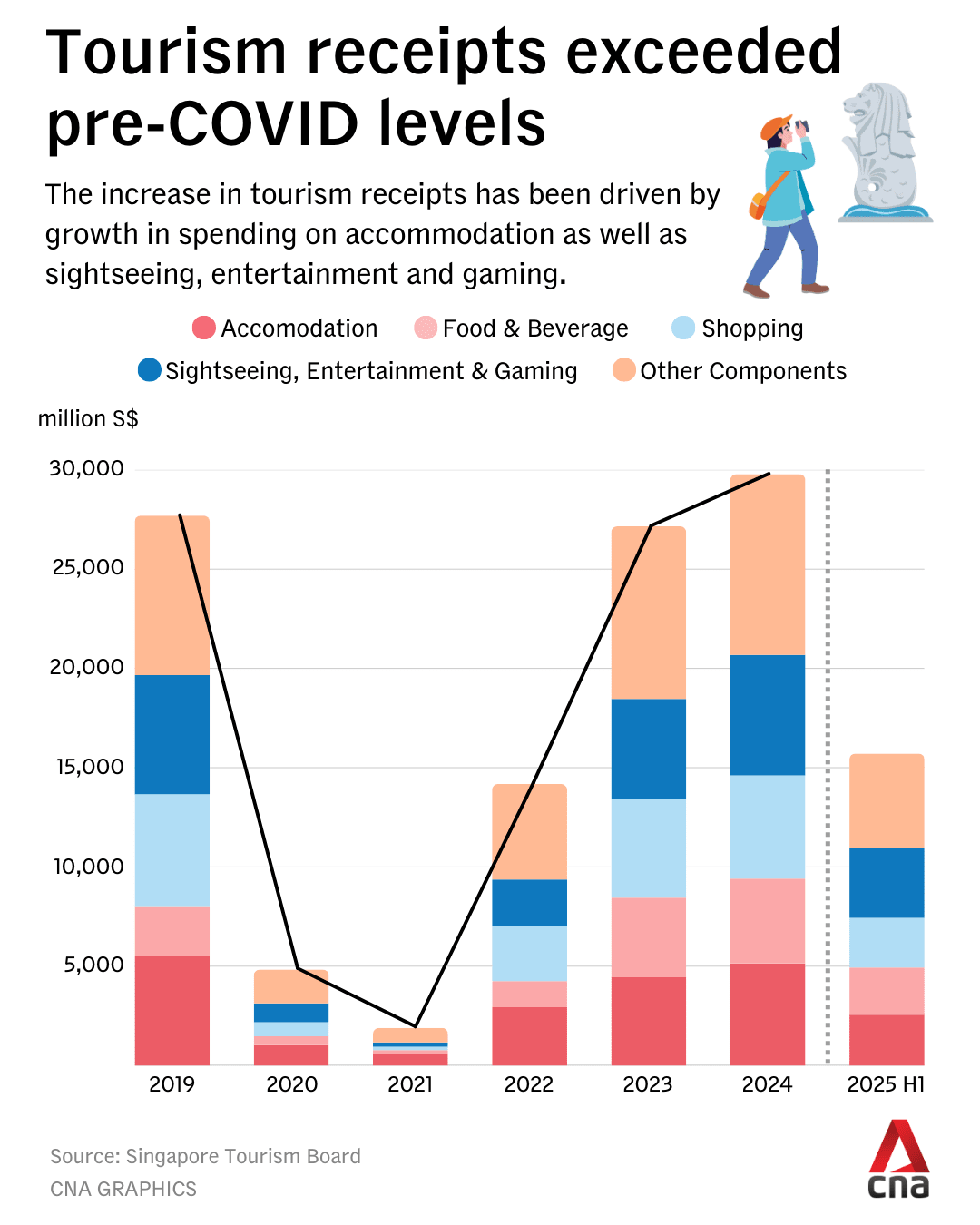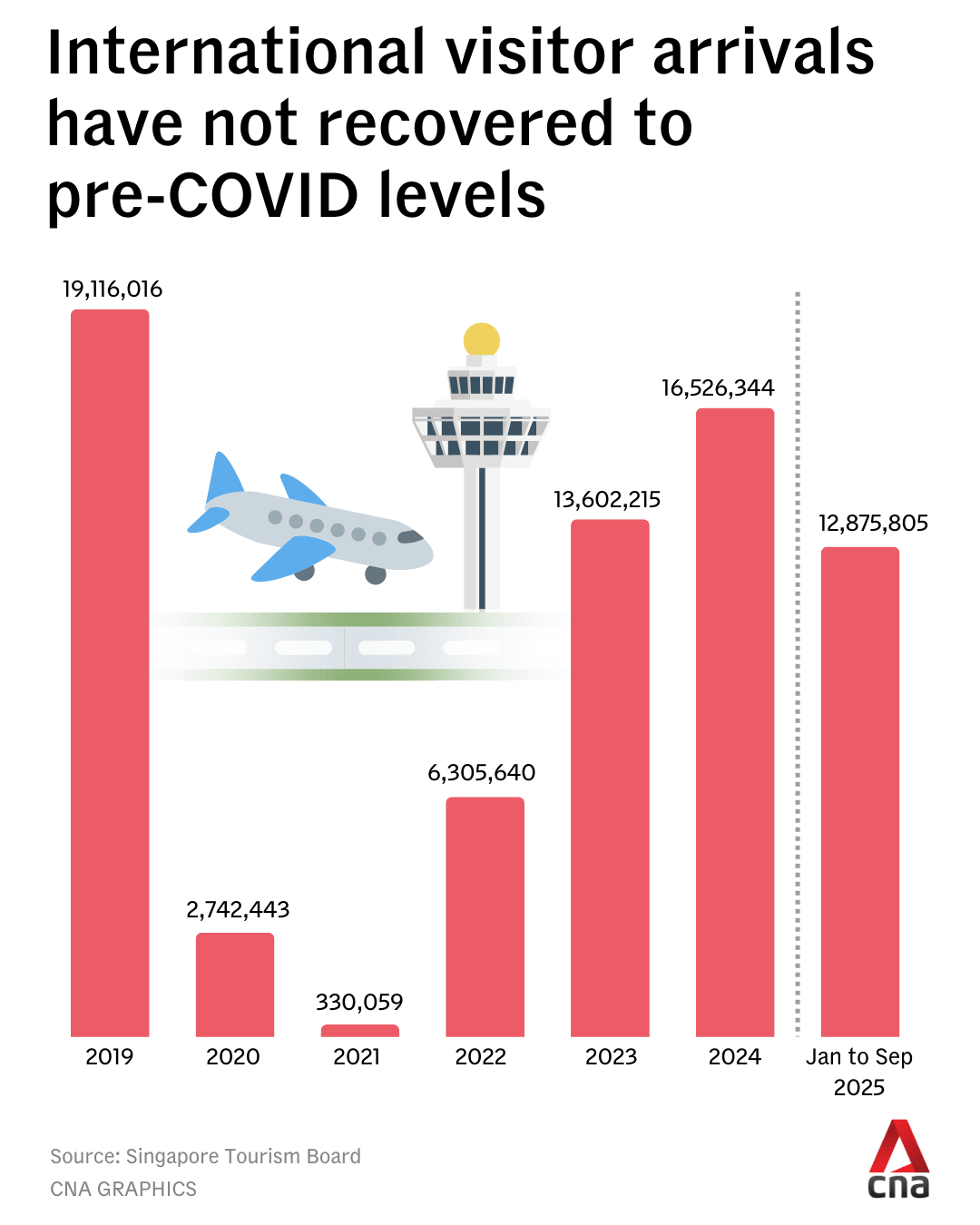Tourist numbers lower than pre-COVID years, but visitors are spending more in Singapore ‚Äď just not on shopping
They are shelling out more on dining, sightseeing, entertainment and gaming, and spending less on accommodation and shopping compared with before the pandemic.

Marina Bay Sands on Sep 11, 2025. (Photo: AFP/Roslan Rahman)

This audio is generated by an AI tool.
SINGAPORE: Tourists are shopping less, but spending more on dining and other experiences, bringing total tourism receipts above 2019's levels despite fewer tourists coming to the country.
A report by the Ministry of Trade and Industry's Economics Division, which had input from the Singapore Tourism Board (STB), found that the spending per visitor increased by 24.4 per cent from 2019 to 2024, which pushed tourism receipts up.
"The increase in (tourism receipts) in 2024, compared to 2023, was driven by robust growth in major spending components, including sightseeing, entertainment and gaming ... and accommodation," the researchers said on Friday (Nov 21). "This surge in spending was supported largely by a strong line-up of events (for example, concerts and marquee leisure events) during the year."
Tourism is a key pillar of Singapore's economy, contributing an estimated 6 per cent to Singapore's services exports in 2024, MTI said. It also plays a critical role in strengthening Singapore's connectivity and reputation.

"2019 was when tourism in Singapore was at its peak, when all stars seemed aligned before COVID struck," said Mr Christopher Khoo, the managing director at tourism consultancy MasterConsult Services.
That year, Singapore received 19.1 million international visitor arrivals and posted S$27.7 billion (US$21.2 billion) in tourism receipts, according to STB data. Both figures plummeted when the pandemic arrived and countries closed borders or imposed strict quarantine requirements.
Last year, Singapore received 16.5 million tourists, but tourism receipts hit S$29.8 billion.
MTI said the cumulative growth of 7.6 per cent in tourism receipts was supported by an increase in spending per visitor, more than offsetting the shortfall in international visitor arrivals in 2024 compared with 2019.
Analysts pointed out that inflation could have caused tourism receipts to rise, but noted that the increase has not been even.

SHIFT AWAY FROM SHOPPING
Compared with 2019, food and beverage tourism receipts in 2024 soared 71 per cent. In stark contrast, accommodation and shopping tourism receipts dipped 7 per cent and 7.8 per cent respectively.
In 2025, spending on F&B, accommodation and sightseeing, entertainment and gaming also increased, offsetting a decline in spending on shopping.
"There is a clear shift toward experiences over goods, with dining and entertainment gaining share since the post-pandemic recovery period," said Mr David Mann, Asia Pacific chief economist at Mastercard.
The trend accelerated from 2022, driven by rising hotel and dining prices and travellers prioritising immersive experiences over shopping, he added.
He said retail spending may be lower because of the strong Singapore dollar, and that it currently makes up less than 20 per cent of total spending by a tourist in Singapore. This is around five percentage points down from what a tourist used to spend on retail in 2019.
Mr Khoo said shopping in Singapore is no longer the main draw for tourists that it was 20 to 30 years ago and that it is "no surprise" as the retail industry globally has had to adapt to the dominance of online shopping.
"We are fortunate in that we have expanded our attractions beyond shopping to include many new features and experiences to cater to the tourists of today," he said, adding that Singapore has introduced more family attractions and positioned itself as green and sustainable.
"Food, sightseeing, entertainment and gaming are experiences that need to be consumed in-person and they tend to form the core activities for leisure visitors and to some extent for business travellers as well," said Mr Joshua Loh, the chair of Ngee Ann Polytechnic's tourism and resort management course.
In-person shopping may be more directed toward unique local products, and experiences are increasingly a "core motivator" for travel, he said.
He noted that major concerts and new attractions such as Rainforest Wild Asia and Minion Land at Universal Studios Singapore give visitors something to look forward to when they travel to Singapore.
"As with any destination, Singapore needs to constantly reinvent itself to maintain its appeal in the minds of visitors," he said.
SINGAPORE'S PUSH TO ATTRACT BIG SPENDERS
The MTI report stated that STB hopes to grow Singapore's tourism receipts to between S$47 billion to S$50 billion by 2040, seeking to attract "higher-yield visitors" and to enhance Singapore's appeal as a "premier destination for both leisure and business travel".
The agency sought to extend visitor stays in Singapore to increase spending per tourist, noted Mr Benjamin Cassim, a lifestyle and consumer experience lecturer at Temasek Polytechnic.
Spending may also have risen because visitors who came for entertainment-based events such as concerts usually have higher levels of discretionary income and a greater willingness to spend, he said.
In April 2025, Minister-in-charge of Trade Relations Grace Fu said a segment that Singapore must pursue is visitors who come for meetings, incentives, conferences and exhibitions (MICE).
"On average, a MICE visitor spends two times as much as a leisure visitor, making it an exceptionally valuable segment for Singapore," she said.
Mr Cassim said the STB has to continue putting in effort to improve Singapore's attractiveness.
"The tourism market is a highly competitive one and there is really no resting on one's laurels," he said.










